Getting Started in The Tattoo Artist Industry
What is a Tattoo Artist Portfolio?
Tattoo artistry dates back thousands of years. While we can’t pinpoint exactly when tattooing became popular, we can find evidence of Ancient Egyptian mummies having tattoed skin, which would place the beginning of tattoos on human skin around 3370 BC and 3100 BC.
In fact, the oldest Ancient Egyptian mummy is said to have had a total of 61 tattoos found on his mummified skin.
Of course, Ancient Egypt isn’t the only area where we find a history of tattooing. Remains of bodies found in Alaska, Mongolia, China, Russia, and the Philippines all have a rich history of tattooing.
Each culture had a presumed different reasoning and meaning behind tattoos, ranging from decorative purposes for the elite to marks of shame for outcasts in society.
To get a better understanding of what a tattoo artist does in modern times, let’s first look at the definition of an artist in general.
The definition of an artist is:
- A person who creates paintings and/or drawings as a profession or hobby
- A practitioner of the creative arts (i.e. sculptor, novelist, filmmaker, etc.)
- Any person who excels with a particular skill
To understand these definitions as they relate to a tattoo artist, let’s break them down more specifically.
The definition of a tattoo artist is:
- A person who creates drawings specifically on human skin (i.e. tattoos)
- A person who consistently practices their creative skills through tattooing
- A person who excels at providing a certain style of tattoo
To sum it up: A tattoo artist is someone who creates permanent images on human skin using specialized tools and ink.
Building a successful career as a tattoo artist requires a great deal of training and skill. This will become clearer as we look closer at what it means to be a tattoo artist and how to get there.
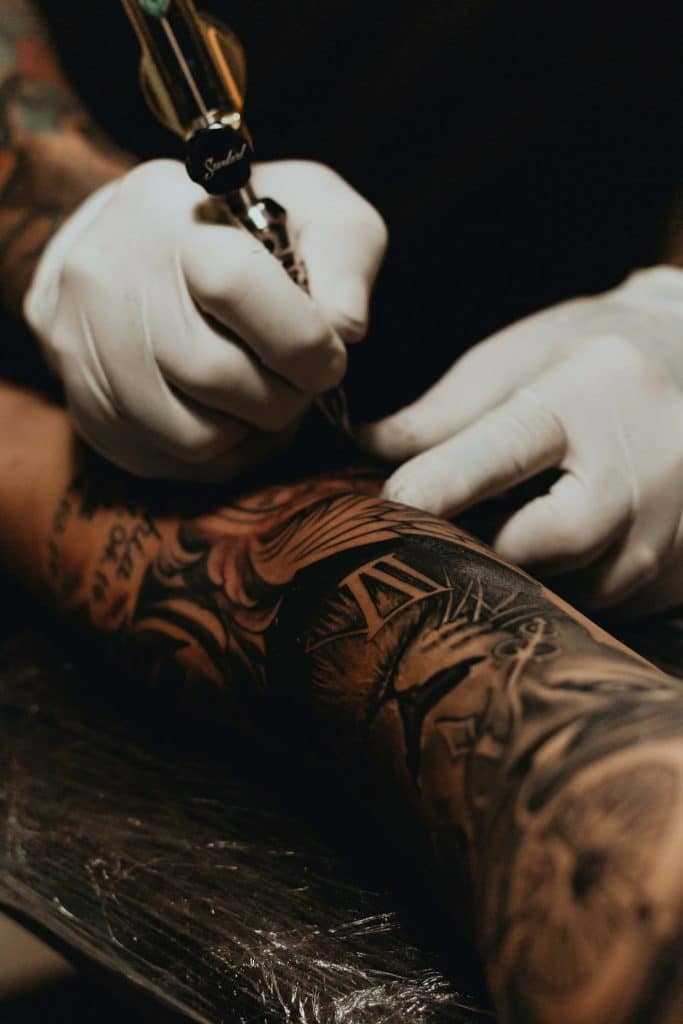
New and established tattoo artists alike rely on tattoo portfolios to showcase their work, apply for a tattoo apprenticeship or job at a tattoo shop, and connect with new potential customers. No matter where you are in your career in the tattoo industry, it’s never too early to create your own tattoo art online portfolio website.
If you’ve been doing tattoo work for a long time, you may be used to the more old school approach of gaining new clients through word of mouth. These days, though, there’s no better way to position yourself as a professional than by showing off pictures of your tattoo designs on your online portfolio. If creating your own portfolio website is out of your comfort zone, there’s no need to worry! We’ll be covering everything you need to know about how to create a tattoo portfolio using a website template to document your tattoo style.
Artistry of all types requires time, patience, and dedication to the craft. With tattoo artistry, in particular, because we are dealing with permanent artwork that resides on a person’s body, honing your craft and developing your skills becomes even more essential. If you’re interested in getting started in the tattoo artist industry, the journey can be long and challenging, but if you stick with it, the payoff is worth it.
Let’s review all that you need to know to get started as a tattoo artist.
What is a Tattoo Artist Portfolio?
Every artist needs a portfolio, and tattoo artists are no exception. A tattoo artist portfolio is a website or landing page where you can explain who you are and what you do, show pictures of your sketches and finished tattoo work, and let people know how they can book your services. Some website builders even allow you to create an online store where you can sell products like your original artwork, prints, or tattoo flash pages.
As a tattoo artist, you probably already know how important referrals are to your business. An online tattoo portfolio website gives you the opportunity to gather positive testimonials and reviews and showcase them alongside your tattoo designs, rates, and contact information.
Do I Need a Tattoo Artist Website?
Whether you’re trying to get an apprenticeship with a mentor at local tattoo shops or you want to build up your clientele and book more tattoo appointments, you need some sort of portfolio where you can display your tattooing skills.
If you’ve already created social media pages to show your tattoo art, you may think that investing time and money into creating your own tattoo artist portfolio isn’t worth it. While social media can be a great tool for growing your audience and reaching new potential clients who are interested in tattoos, a fully customized online portfolio will communicate your professionalism and credibility as a tattoo artist in a way that a social media profile never can.
Another benefit to creating your own portfolio website instead of relying on social media is that you have much more control over how your site is designed. This means that you can choose what information and pictures to include and how best to organize them to impress site visitors with your tattoo work and style. Plus, some tattoo portfolio template options allow you to set up an online store so that you can make passive income while you sleep.
When it comes down to it, a professional tattoo portfolio is as important an investment as your tattoo machine, needles, and inks.

What Are The Different Types Of Tattoo Artists?
All tattoo artists do the same thing: place permanent ink artwork on their client’s body using specialized techniques and tools. What differs between each tattoo artist is their style.
This is why it is so important to take the time to develop your unique style when you start out as a tattoo artist. As you build your tattoo portfolio, you are essentially defining the type of tattoo artist that you are, and the type of clients that you will attract. If you try to do it all, you likely won’t ever become great at one style.
We recommend finding a style from the list below and then working to master that particular style.
Here are just some of the different types of tattoo artists:
Classic Americana: Likely the style that comes to mind when you think of traditional tattoos; makes use of thick lines and a similar color palette; some traditional symbols used include daggers, roses, and hearts
Neo-Traditional: This style is similar to the classic style above except often thinner lines and nontraditional colors are used to present a more contemporary look
New School: These tattoos have an almost comic book aesthetic to them; vivid with plenty of color present
Japanese: Symbols, colors, and imagery are all used to bring about an aesthetic that feels Japanese inspired
Black and grey: This style is less about the imagery and more about your use of shading; can depict everything from feminine florals to more dramatic skulls
Watercolor: Also more so about the colors used than the subject; this style is minimal, delicate, and most often appeals to women
Portraiture: This style of tattoo requires extreme attention to detail. Without skill the tattoo might not resemble the subject, which defeats the purpose of getting a portrait tattoo in the first place
Stick and Poke: Using a single needle, these tattoos are applied by hand instead of using a tattoo machine. They are rather simple in nature and are typically characterized by dark, thick lines but also allow for a wide range of intricacy and detail
Realism: These artists focus on capturing realistic pieces of art on the body; can range from objects to animals to full scenes; requires a skilled and experienced artist to get it right
Blackwork: Similar to a tribal tattoo, these pieces use thick, black lines to display geometric shapes
Biomechanical: A very unique and specific style, this tattoo mimics the idea of machinery held within the body, underneath the surface of the skin
Geometric: Utilizes exact and sharp lines; often done in combination with organic elements like flowers
Realistic Trash Polka: A very specific style, this type of tattoo artist specializes in a style that is meant to mimic a collage of printed materials, which can include newspaper clippings, paint splashes, and typewriting
Surrealism: With plenty of room for interpretation, this style gives artists plenty of freedom to play with subjects, colors, and combining various styles; sublime fantasy
Depending on who you ask, we could add more styles to this list, but in general, rather than being concerned with falling into one of these categories, you should be most concerned with developing your own style that is signature to you.
You can mix and match styles, experiment with fresh takes on traditional techniques, and even try out different styles over time as your career and reputation expand.
Remember: The only different difference between yourself and a traditional artist is that your work is being done on a different canvas. As with all styles of art, developing your style takes time, commitment, and patience.
What are Tattoo Website Templates?
Not too long ago, if you wanted to make your own website to show off your tattooing skills and artwork, you would have needed to learn website design and coding or hire a professional web developer. Now, tattoo artist website templates enable you to create fully functional and customizable websites on your computer with ease in minutes.
A great website template will provide an intuitive, user-friendly website builder you can use to add, rearrange, and move content as you please. Tattoo artists frequently use templates found on websites when building their portfolios.
Ready to create your tattoo artist portfolio?
Showcase your tattoo work and creativity with an online portfolio website.
What Features Should I Look for in a Tattoo Artist Portfolio Template?
With so many options out there, choosing the right template for your tattoos can be tricky. That’s why we’ve narrowed in on the features that you should make sure to look out for when selecting your tattoo portfolio website builder.
Professional design. Just because you’re creating it on your own doesn’t mean that your portfolio should look any less professional than if you had hired an expert. Choose a portfolio builder that prioritizes design that will make your tattoos stand out, no matter what your style is.
Intuitive editing. As a tattoo artist or apprentice, the last thing you want is to spend unnecessary time and effort trying to make your site look the way you want it to. The right template will be easy to use and fully customizable.
A variety of template designs. Not all tattoo artists are alike, and your portfolio needs to represent your specific and unique style. That’s why you need to have the option to choose from a variety of templates to select the one that works best with your artwork.
Mobile optimization. While your portfolio may be best viewed on a computer, you can’t control what device people will use to visit your site. A mobile-optimized portfolio means that your designs will always look amazing, no matter what device your visitors are seeing them on.
Responsive Design. When customers visit your site, you want them to have a smooth, instant-viewing experience. Format uses responsive website templates that load fast and work on all screens. You can test your mobile speed with Google by entering your page URL, as well as get recommendations to improve it by removing unnecessary JavaScrip or optimizing your image file size.
High-quality images. When you photograph your flash sheet and tattoo styles, you want the quality of your artwork to be clear. Don’t sacrifice your image quality for better page load times or vice versa. The right portfolio builder will allow you to show the very best pictures without affecting the time it takes for each of the sections to load.
Search Engine Optimization. Once you’ve set up your portfolio, you’ll probably want to make sure that people are actually seeing your artwork. That’s where SEO comes in. Use relevant keywords throughout your portfolio so that when people search online for the services that you offer, your work will come up first.
Online store. If you’re already going to the trouble of creating a portfolio to show your tattoo styles, you may as well set up an online store while you’re at it. Choose a portfolio template that includes the option to create an online store where you can sell both physical and digital products with no commission taken.
Custom domain name and email address. Nothing says professionalism like a custom web domain and a matching email.
Privacy settings. Protect your work by using features like a watermarking tool, password-protected photo galleries, and disabling right click save on your pictures.
Blogging tools. In addition to SEO, writing a blog is a great way to get new eyes on your tattoo pieces. Make sure that you’re using keywords in each post and that you’re writing about topics that are interesting for your dream clients.
Free trial. Before you invest your money, take advantage of a portfolio builder that offers a free 14-day trial, so that you can test out their templates to be sure that they work well for you.
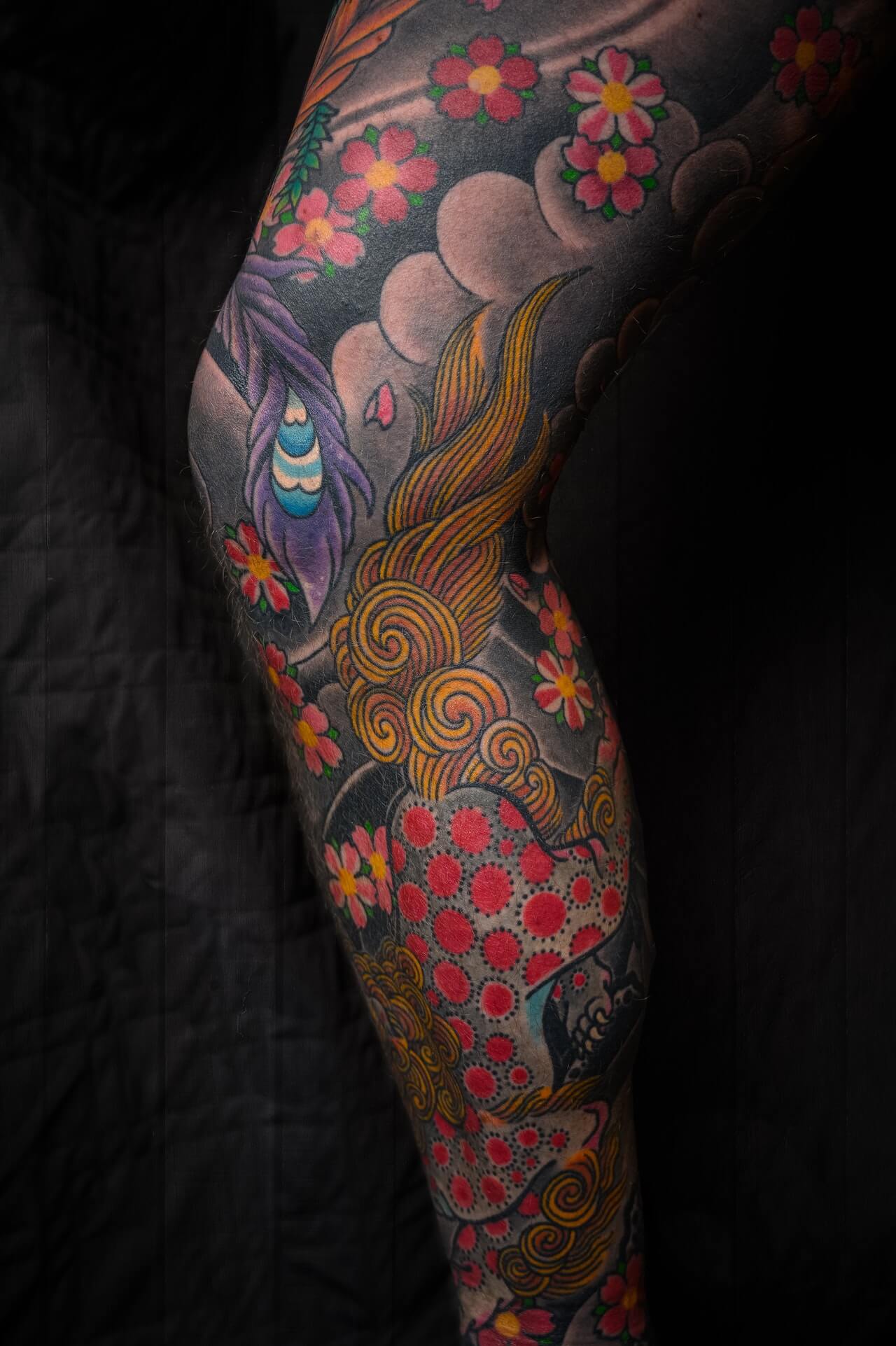
How Do I use a Website Template to Create My Tattoo Portfolio?
Now that you understand why you need an online portfolio for your tattoos and what features to look for, it’s time to break down how to create a tattoo portfolio.
Choose your template. When selecting your template, keep in mind your aesthetic as a tattoo artist. Every choice that you make in creating your portfolio should reflect who you are and what your art is about.
Create a gallery page and add photos of your work. Upload your best tattoo pieces, as well as any flash sheets or sketches that you think will add to your portfolio. You should aim to limit your portfolio to no more than 20 pieces so that you don’t overwhelm your visitors with visual information.
Add an about me page and your contact information. While people may originally find you through your tattoo pieces, it’s important that you also let them know who the person behind the art is. Explain how you got into tattooing and provide ways for people to get in touch and book your services.
Set up your online shop. You can sell pretty much anything in your e-commerce store, from art prints to flash sheets to tutorial videos for new tattoo artists.
Link your social accounts. It’s always a good idea to include links to the social sites where you are most active so that people can connect with you and engage with your art on a variety of platforms.
If you’re still not sure what your portfolio should look like, use some tattoo art portfolio examples to get inspired.
Tattoo Portfolio Examples
If you’re still not sure what your portfolio should look like, use some tattoo art portfolio examples to get inspired. Looking at other artists is a great way to blend tattoo portfolio ideas and find your creative spirit. Tattoo artist portfolio examples also give you an opportunity to learn more about your competitors and what customers are looking for.
When comparing tattoo apprenticeship portfolio examples, look for structural elements that will help you and your work stand out from the pack. Format has a range of tattoo artist portfolio examples and templates to help you convey your work in your own, professional manner.
With these principles in mind and an advanced portfolio builder like Format, you will set yourself on a successful career path to professional tattoo artistry.
What are the Best Tattoo Artist Website Design Templates?
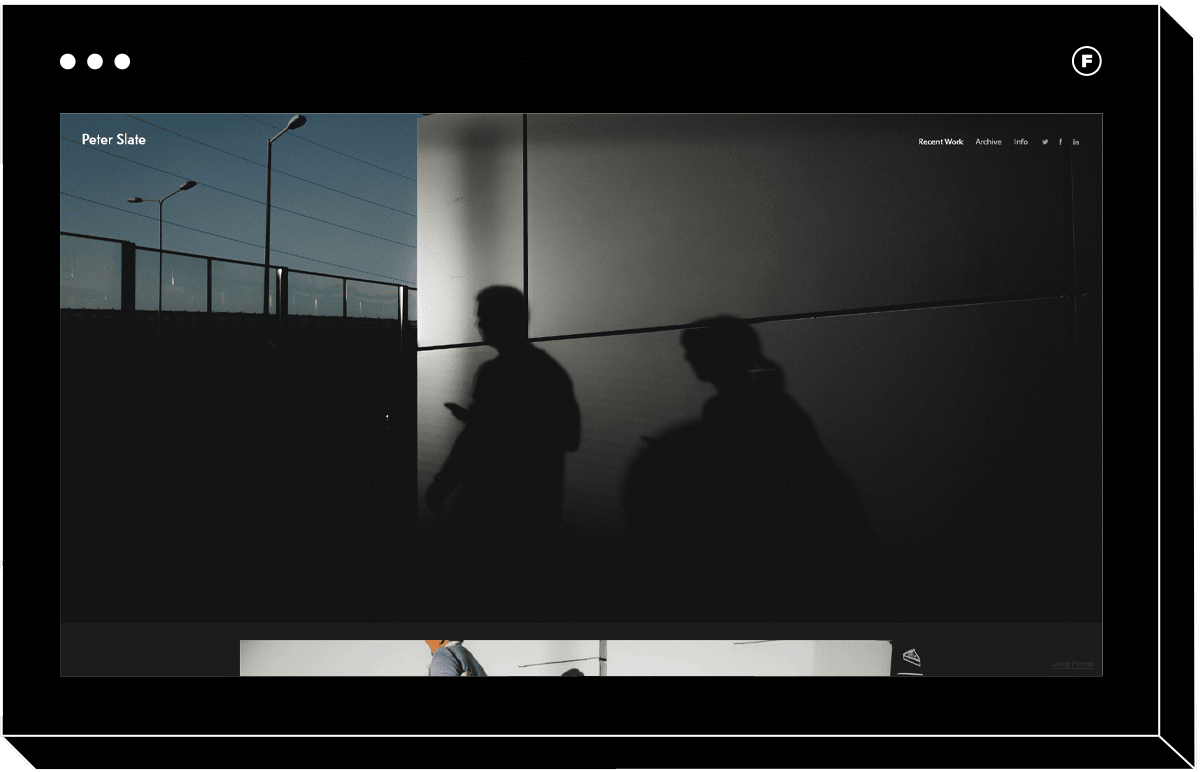
Slate
Slate is a slideshow template that uses a parallax scroll and supports full-width images to show your work in the best light. This setup allows visitors to focus on one image at a time to fully appreciate the details, while still experiencing it in the context of your other work.
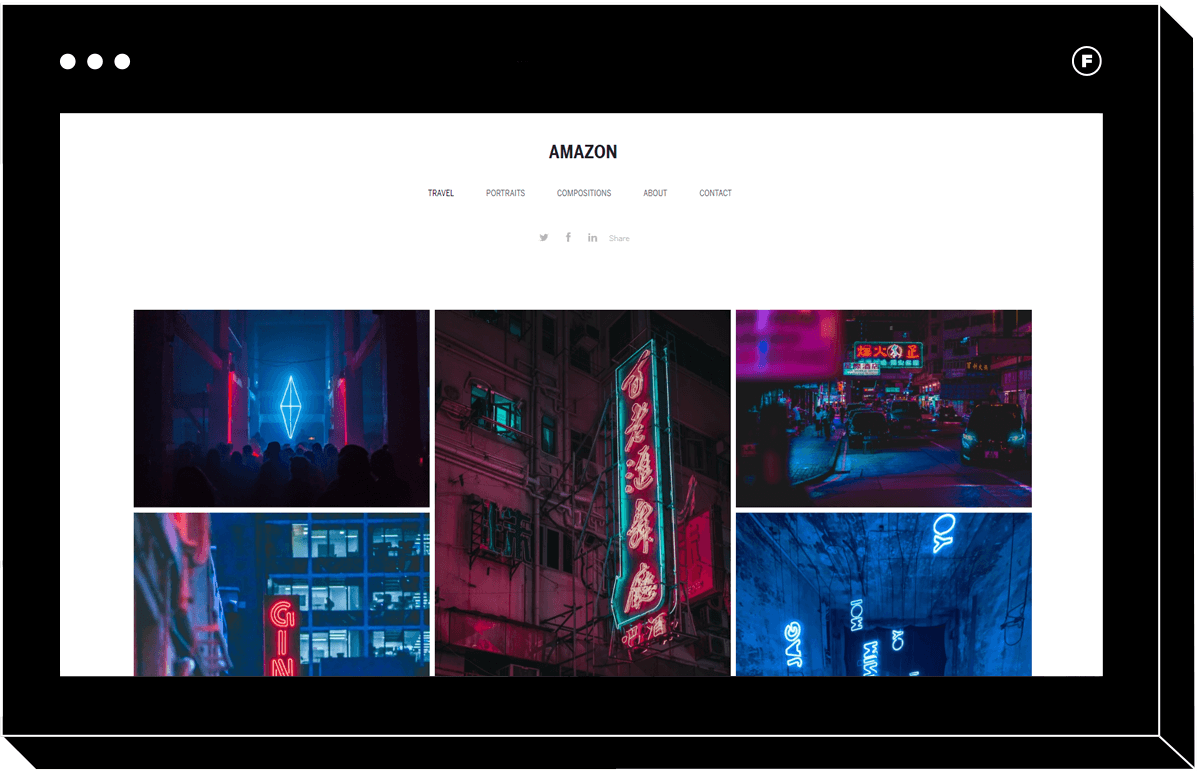
Amazon
Youthful, fun, and image forward, Amazon uses a masonry-style grid with a fully customizable tiled image layout.
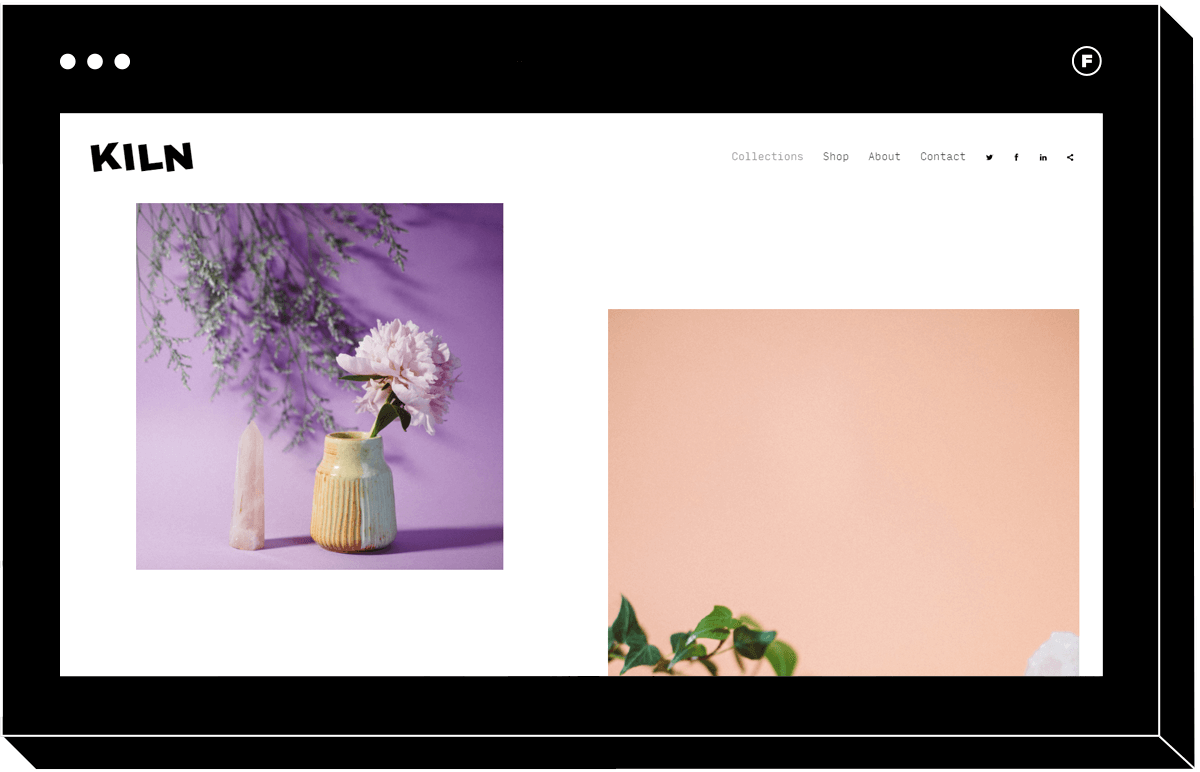
Kiln
Kiln uses a tiled layout that supports large photos in order to emphasize detail. It also offers custom spacing, columns, and scroll indicators.
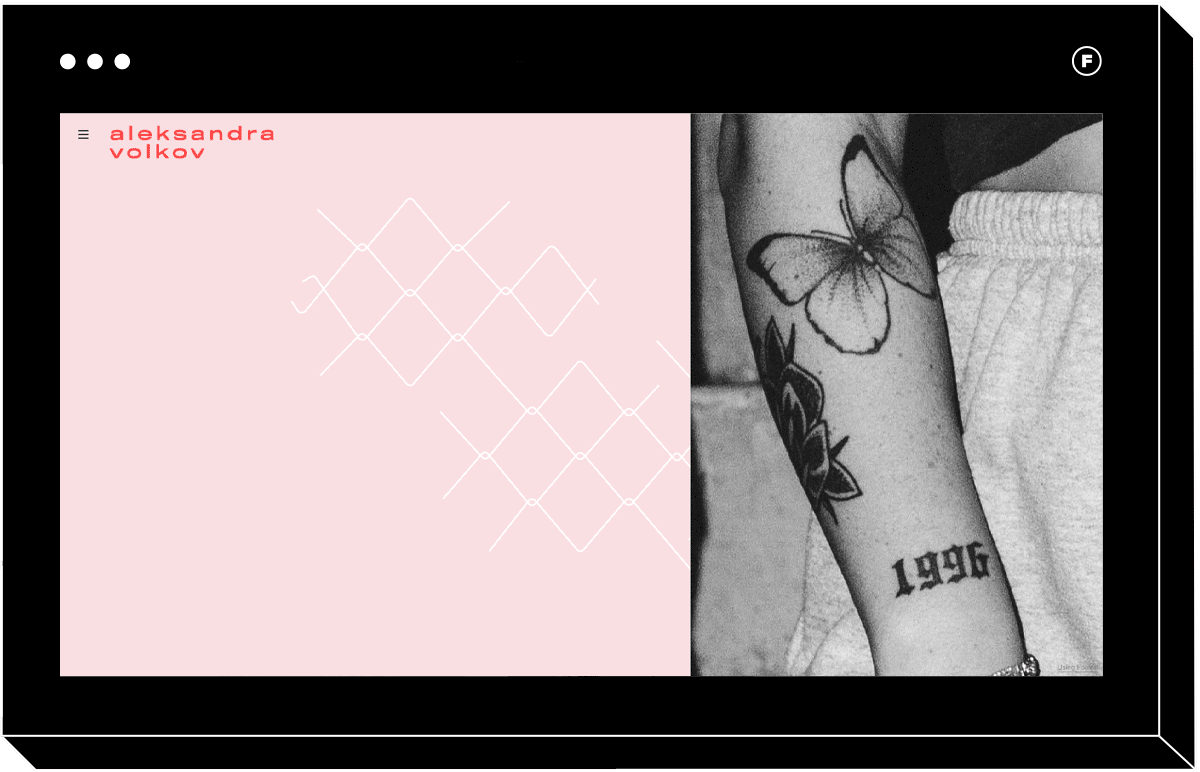
Flash
Flash is a bold, design-forward template with a staggering image layout. This allows you to showcase different image sizes and orientations. It also comes with a unique menu layout and uses vertical scrolling.
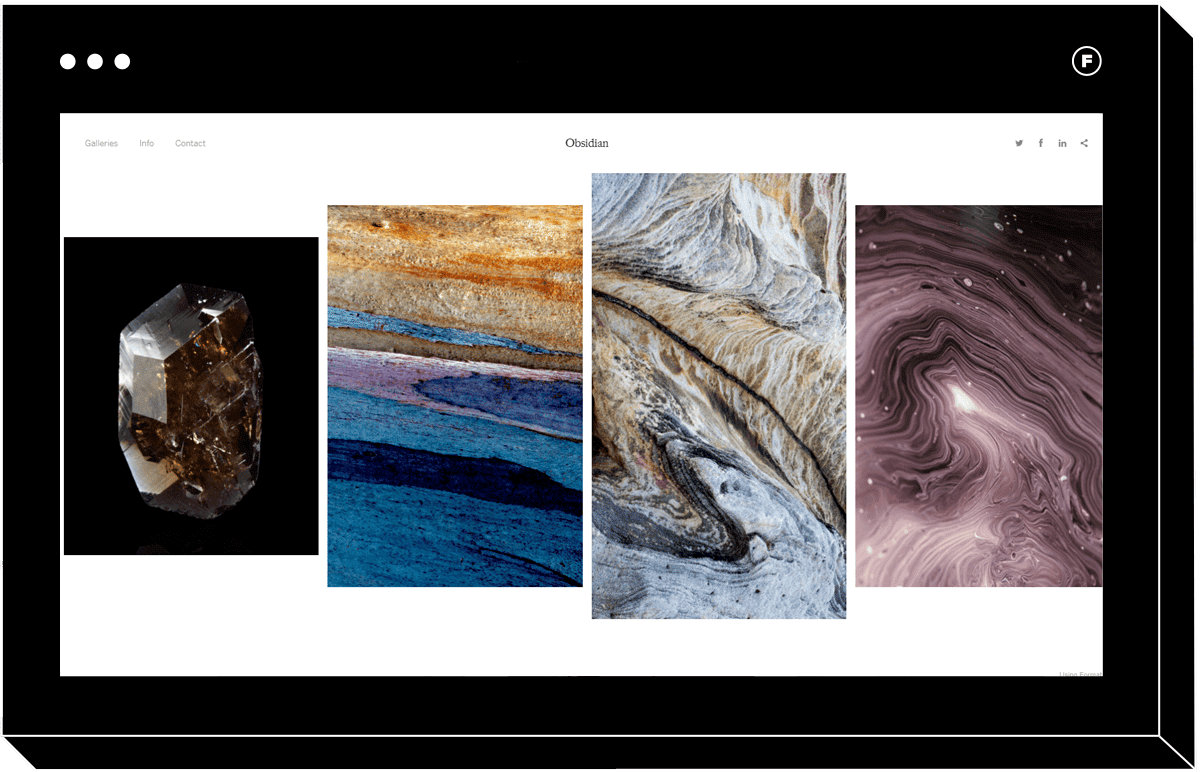
Obsidian
This film strip style template uses a horizontal scroll and is best for showcasing work where each image is unique and different. The galleries can accommodate both images and text so you can provide the context in the same place as you show off your tattoo style.
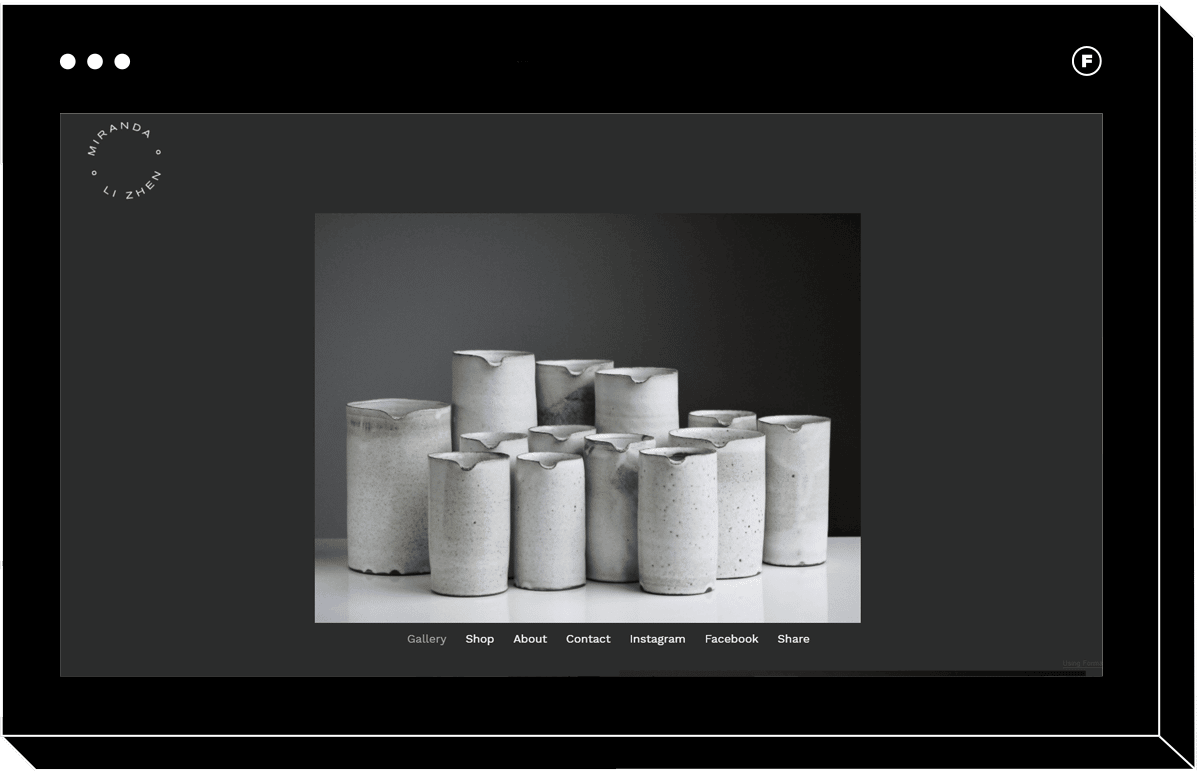
Balance
Balance’s tiled template allows you to display multiple images at once with custom gallery and column spacing.
Now that you know everything there is to know about creating a tattoo portfolio using a template, you’re ready to start building your online portfolio. We can’t wait to see all of your awesome tattoo designs on your brand new website.
How do I Market my Tattoo Portfolio Website?
So now you know how to make a tattoo artist portfolio, but how do you share it with the world? Using the right marketing tools can give your tattoo portfolio website the exposure it needs to reach new clients and further grow your customer base. We’ve outlined some portfolio essentials for an effective marketing strategy.
Social Media: Many tattoo artists use social media to market their work by integrating their portfolio with their social accounts and sharing content on those platforms ensures maximum engagement and traffic to your portfolio site.
Google Advertising: Google still dominates the search engine space, and well-placed ads in your local area with the right keywords can help bring hot leads to your portfolio. Focus your search terms locally, so that you’re spending your ad dollars on the most likely customers, as opposed to customers from far cities that are least likely to come to you due to distance.
Special Offers: Offering freebies is a great way to entice first-time tattoo clients to come to you over your competitors. Consider what you are able to provide as a free starter offer and then the upsell strategy once your clients are ready to commit.
Email Marketing: If you’re getting hits on your portfolio site, collecting email addresses is a great way to improve lifetime value of your customers. Whether someone has engaged in your tattoo design services before or is considering it for the first time, an effective email marketing strategy will always keep you on their mind.
Networking: You have probably heard the saying “networking is an investment in your business.” In the digital age, never has this saying been more true. Sharing your new portfolio site digitally through LinkedIn and physically at events and in your store will help spread the word faster. Consider putting your brand new website domain on some business cards, flyers, and even a QR code link for customers to see your portfolio instantly.
Why Choose Format for your Online Tattoo Portfolio?
If you are serious about expanding your career with an attractive, online tattoo portfolio, look for a platform like Format that offers beautiful templates for any tattoo artist professional. Express yourself and your work instantly with our range of templates design with creative artists in mind. With an easy-to-use platform, advanced visual editor, and kickstarter guides, we’ve got all the tools to make your tattoo artist career a success.
What Are Some Tattoo Artist Examples?
One of the easiest ways to get a better feel for what a tattoo artist is is to look more closely at the work of artists who already run successful tattooing businesses. This way, not only will we be able to see the artistic skill and creativity that goes into their work, but we can also browse through their portfolio/website to get a feel for how they market their services to prospective clients.
Loren Fetterman
Loren’s journey into tattoo artistry was not immediate. This tattoo artist first began his career as a concept artist. It wasn’t until after graduating from school that he started to experiment with expressing his artwork on the skin.
In his portfolio, you’ll notice that he has split his work into both his original artwork and his tattoos. This allows people who are interested in his tattoos to specifically locate past pieces, while those who aren’t interested in a tattoo but still enjoy his work can also find what they are looking for.
Also, take note that whether we’re looking at tattoo pieces or not, the style of artistry is similar, further illustrating just how important it is to keep working on your craft in order to develop a signature style that you can display in a portfolio.
Loren uses the Amazon theme from Format to display his portfolio.
Sink The Ink
This portfolio provides a great example of how a tattoo studio can showcase the portfolio of multiple artists on one easy-to-navigate website.
With a left sidebar navigation, you can click and choose which artists you’re interested in viewing and then scroll through their portfolio of past pieces.
Images used are up close, large, and provide viewers with great detail of the piece, which is essential when showing off your work.
Sink The Ink uses the Gloss theme from Format to display their work.
Andrew Constable
With a background in graphic design and illustration, this portfolio is easy-to-navigate, providing you with a left navigation bar with all the menu labels you might expect (i.e. about, blog, tattoos, contact, etc.)
This portfolio goes to show that you don’t need to overly complicate your portfolio in order to show off your work. Try out the Order theme if this style of portfolio appeals to you.
For more examples of exceptional tattoo artists, we highly recommend browsing through this list of tattoo artist portfolio examples.
How Do You Get Started In The Tattoo Industry?
As with most creative pursuits, there is no one guaranteed path to becoming a tattoo artist. Having said that, there are some general milestones you should aim to hit if you’re looking to grow a career as a tattoo artist.
Use these steps as a general guideline when pursuing a career as a tattoo artist.
Step 1: Develop your general art skills
We’ve said it before but it’s worth repeating: If you don’t take the time to develop your art skills, it’s unlikely you’ll have success as a tattoo artist.
As someone who is placing permanent artwork on people’s skin, your work needs to be professional at all times. Again, we’re talking about permanent pieces of artwork that live on the body—there is no room for errors here.
We also recommend experimenting with other art forms in this initial stage. While you might be convinced that tattoo artistry is your passion now, there also might be a style of art that is more in tune with your style and methods. Don’t put all your eggs in one basket in this initial stage. Becoming a tattoo artist takes a lot of time and dedication, so you want to be sure that this is the right path for you prior to investing your time and resources.
Step 2: Education
Tattoo artists do not require any formal education in order to have success. Having said that, most successful tattoo artists will have some level of education, which can include self-education.
Read design books, study the work of other artists, play with different mediums, and don’t be afraid to pursue a fine arts education if you have the resources.
This step is going to look different for everyone, but no matter what, it is essential that you’re constantly learning and gathering as much design knowledge as possible in these initial stages of your journey.
Step 3: Putting together a portfolio
When starting out as a tattoo artist, you’re obviously not going to have examples to show off tattoo work specifically. However, that doesn’t mean you shouldn’t start putting together examples of your drawings in order to show off your style.
A solid, professional portfolio will also help you in obtaining the right apprenticeship, which we’ll discuss in the next step
What should I include in my portfolio?
Your portfolio should only include your best pieces of work. While you may be tempted to share everything, remember, your portfolio is your professional resume. You want to use your portfolio to attract the right people to your work. If you’re trying to appeal to everyone, there’s a solid chance that you’ll appeal to no one.
How do I create a portfolio?
While you certainly can have a physical portfolio, more often than not, you’ll also want to have a digital copy of your portfolio that you can easily share with anyone. All you need is a simple business card that includes your website and you’ll easily be able to share, whereas, with a physical portfolio, you always need to have your portfolio on you if an opportunity presents itself.
If you don’t have the technical skills necessary in order to put together a website that houses your portfolio, don’t forget that Format provides professionally designed portfolio templates that will help you have your website up and running in no time.
How can I make my portfolio stand out?
How to put together an engaging tattoo artist portfolio is a separate post in and of itself—in fact, we have a full guide on portfolios for tattoo artists, but in general, here are some of our best tips when putting together your portfolio as an aspiring tattoo artist:
Your portfolio should be easy-to-navigate
Ensure that your images are high-quality and large enough to see on any device
Your website should be mobile responsive, meaning your website should look just as good on a cell phone as it does on a desktop or tablet
Utilize some branding techniques that match with the style of tattoos you plan on pursuing
Develop a strong About page
Don’t forget to provide a contact form
Link your social media accounts
Be sure that viewers can quickly and easily find your work on your website
If you’re still uncertain, you’ll find more tattoo artist portfolio examples here that will give you a better idea of what a portfolio using Format could look like.
Step 4: Work as an apprentice
If you want to be taken seriously in the tattoo industry, working with someone who has already established a successful career is key to helping you develop your skills.
During this time you’ll work as an apprentice, gaining the hands-on skills that you need in order to be a tattoo artist that clients trust. Remember: As much as gaining some education is important—whether self-taught or in a formal setting—you can’t learn the art of tattooing from a book. You need to get hands-on experience with the guidance of a mentor.
Step 5: Obtain all necessary licensing and certification
You can’t simply become a tattoo artist without being properly licensed. Each state is slightly different, but in general, you may have to take courses on disease control and other health and safety protocols.
Step 6: Obtain your supplies
Before you start booking clients, be sure that you have all the supplies and equipment necessary in order to provide clients with a five-star experience.
You want to start your career off on the best foot possible, and being prepared with the right equipment is a great starting point.
Step 7: Open for business
Now, starting a business is no easy feat. Again, this step could be its very own post, but in general, now that you’ve gone through all the necessary education, certification, and hands-on experience, you theoretically should be ready to open for business.
Remember: Establishing a business takes time. Don’t rush the process.
Some things you’ll want to consider when opening your business include branding, marketing, client experience, bookkeeping, social media, and pricing (discussed below).
If you’re looking for more information that specifically pertains to getting your website set up, check out this guide for tattoo artists.
How Do You Price Your Tattoo Artist Services?
Pricing your services can be one of the hardest business decisions for an aspiring tattoo artist. You don’t want to price your services too high or you might struggle to gain clients, but you also don’t want to undercharge for your services. You’re trying to operate a profitable business, after all.
Here are the two most common ways that tattoo artists charge for their services:
You can charge by the hour
Probably one of the more popular methods for pricing your services, you can charge by the hour.
Many tattoo artists find this method most effective because it ensures that you’re fairly being compensated for each hour that you spend on a tattoo.
When charging by the hour, don’t forget to keep in mind:
Prep involved prior to the actual appointment
Any custom artwork done outside of the scheduled appointment
Cost of ink/supplies
Cost of colored ink vs. black ink
Your client should have a rough idea of how long the tattoo will take to avoid any cost surprises
Similarly, you should know how long a tattoo will take to avoid any scheduling complications
You can charge by tattoo size (fixed price)
Some tattoo artists prefer to charge a fixed price, meaning regardless of how long the piece actually takes to complete, the client is given a fixed-rate at the beginning of their appointment and expected to pay that sum at the end of the appointment.
Some tattoo artists prefer this method because it gives clients an exact idea of what their tattoo will cost.
When charging a fixed price, don’t forget to keep in mind:
Sometimes the smallest tattoos can be the most complicated. If you find this is the case, don’t base your fixed price on the size of the tattoo, but rather on some other fixed factor
Is the client asking for a custom piece or coming in with an already complete sketch of what they want?
Where is the tattoo being placed? Some areas of the body are more difficult to work with, which could impact the quote you give your client
Operating costs (these costs might not be something the client takes into account when purchasing their tattoo, but if you provide a premium experience, your prices should reflect that)
General Pricing Guidelines
These are not set-in-stone price guidelines, but they can help give you a better idea of what to charge.
In general, tattoos range from $50 to $4000+.
For most apprentices who are still working under the supervision of a mentor, you’ll find that $30/hour is a fairly standard rate.
For an experienced artist, charging $150/hour is more realistic.
As you can see, there is quite a bit of difference in pricing, so don’t get too wrapped up in these guidelines. Your prices will likely fluctuate over time, and as a business owner, you always have the ability to change prices to figure out what works best for you.
Pricing tips for new tattoo artists
If you’re uncertain about whether you should charge a fixed price or by the hour, you might find that hourly is best to start off with, especially if you’re still trying to figure out how long tattoos will take to complete.
Alternatively, if you’re not sure how long a tattoo will take to complete, you don’t want to scare a potential client off by invoicing them a ten hour tattoo that you thought would only take 5 hours. In this case, don’t start with complicated and/or large tattoos.
Starting smaller and less complex will give you a solid start to your career, allowing you to slowly build your client base.
As you build your experience, you’ll have a better idea of the time, energy, and effort required of different styles and sizes. Plus, as is the case with most services, as you gain experience and a reputation you’ll be able to charge higher rates as demand for your expertise increases.
Starting Your Career as a Tattoo Artist
At this point, you should have a good idea of where to start if you’re hoping to build a career as a tattoo artist.
You also likely recognize that becoming a successful tattoo artist takes a good deal of time, energy, and patience.
If you’re certain that this is the career for you, start slow and build as you go. And, when you’re ready, don’t forget that Format has professionally designed portfolio templates ready for all your website needs.
Get started today.